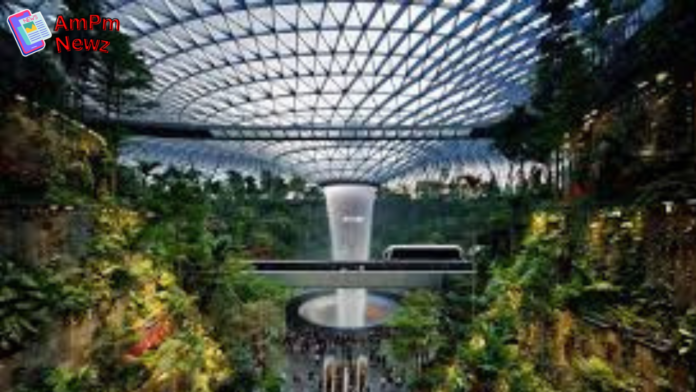🌱 Introduction
In an age of rapid urbanization, humans are becoming increasingly disconnected from nature. Biophilic Architecture is a revolutionary approach that reintegrates natural elements into the built environment, improving aesthetics, well-being, and sustainability. This architectural philosophy emphasizes the use of greenery, natural lighting, organic materials, and water features to create healthier, more vibrant spaces.
🌿 What is Biophilic Architecture?
Biophilic Architecture is the practice of designing buildings and spaces that foster a connection between people and nature. It is based on the idea that humans have an innate affinity for nature, and by incorporating natural elements into our surroundings, we can enhance our physical and mental health.
🔹 Key aspects of Biophilic Architecture:
- 🌱 Green Walls & Indoor Gardens – Bringing plant life into indoor spaces improves air quality and aesthetics.
- ☀️ Natural Lighting – Maximizing daylight reduces the need for artificial lighting and enhances well-being.
- 💦 Water Features – Indoor fountains and reflective pools create a calming ambiance.
- 🌳 Organic Materials – The use of wood, stone, and bamboo makes structures feel more natural.
🌍 Why is Biophilic Architecture Gaining Popularity?
As cities grow denser, green spaces are shrinking. The stress of urban living has increased the demand for Biophilic Architecture, which offers a refreshing alternative. Some key reasons for its rise include:
✅ Health Benefits – Studies show that access to nature reduces stress, anxiety, and depression while improving concentration and cognitive function. ✅ Sustainability – Natural ventilation, solar energy, and green roofs reduce the carbon footprint of buildings. ✅ Improved Work Productivity – Offices designed with Biophilic Architecture principles boost creativity, efficiency, and job satisfaction. ✅ Aesthetic Appeal – Greenery and natural elements create visually appealing, calming spaces.
🌿 Benefits of Biophilic Architecture
1️⃣ Enhances Mental Well-being 🧘♂️
Exposure to nature has been scientifically proven to lower cortisol levels, reducing stress and anxiety. Offices and homes with Biophilic Architecture promote relaxation and creativity.
2️⃣ Boosts Air Quality 🍃
Plants act as natural air purifiers by absorbing toxins and releasing oxygen, making indoor spaces healthier.
3️⃣ Saves Energy ⚡
Natural ventilation and daylight reduce the need for artificial cooling and lighting, cutting energy costs and reducing emissions.
4️⃣ Increases Property Value 🏡
Biophilic buildings attract more buyers and tenants, as they offer better living and working conditions.
5️⃣ Encourages Sustainable Living 🌏
Using eco-friendly materials and renewable energy sources in Biophilic Architecture contributes to a greener future.
🏛️ Real-World Examples of Biophilic Architecture
Several innovative structures around the world showcase the beauty and functionality of Biophilic Architecture:
🏢 Amazon Spheres (Seattle, USA)
🌿 A workplace that houses over 40,000 plants, providing a tranquil environment for employees.
🌳 Bosco Verticale (Milan, Italy)
🏗️ A pair of residential towers covered with trees and vegetation that help absorb CO2 and provide natural insulation.
🌊 Changi Airport (Singapore)
✈️ Features the world’s tallest indoor waterfall and lush indoor gardens, creating a relaxing travel experience.
💡 The Edge (Amsterdam, Netherlands)
🏢 One of the greenest office buildings in the world, designed to maximize natural light and energy efficiency.
🏡 How to Incorporate Biophilic Design in Your Home
Even if you’re not an architect, you can bring Biophilic Architecture principles into your living or working space with simple changes:
✔️ Add Indoor Plants 🌿 – They enhance aesthetics and improve air quality. ✔️ Maximize Natural Light ☀️ – Use large windows and skylights to reduce artificial lighting. ✔️ Use Natural Materials 🌳 – Incorporate wood, stone, and bamboo into your decor. ✔️ Introduce Water Elements 💦 – Small fountains or aquariums can add a calming effect. ✔️ Create Open Spaces 🏡 – Reducing clutter and increasing airflow can make your home feel more inviting.
🌎 The Future of Biophilic Architecture
As concerns about climate change grow, Biophilic Architecture is expected to become more mainstream. Future cities will likely incorporate more greenery into buildings, rooftop gardens, and energy-efficient designs. Governments and urban planners are recognizing the importance of nature in urban environments, leading to more initiatives promoting sustainable architecture.
✨ Conclusion
Biophilic Architecture is more than just a design trend—it is a crucial step toward creating healthier, more sustainable urban spaces. By integrating nature into our surroundings, we can improve mental and physical well-being, boost productivity, and contribute to environmental conservation.
📢 Read our next blog to explore more fascinating architectural innovations! 🏗️




